How to Check if Your Kids’ Shoes Provide Good Support? – Follow These 3 Steps
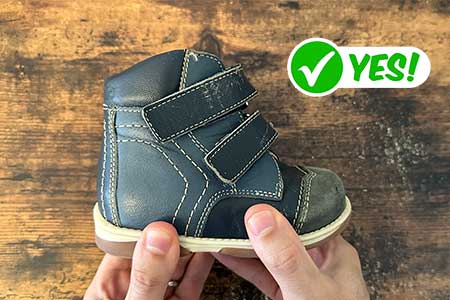
As a shoe fitter with years of experience measuring children’s feet and fitting children’s shoes, I understand the importance of supportive shoes for children with foot conditions. The correct types of shoes can be life-changing. I work closely with pediatric orthopedic specialists and foot issues in kids can lead to potential discomfort and alignment issues. Some of the most common issues range from flat feet to in-toeing, out-toeing, low muscle tone, and toe walking. The good news is that corrective footwear can help treat your child’s foot condition and avoid long-term complications.
Parents of children who don’t have any foot conditions can choose pretty much any type of shoe, as long as the shoe fits their child’s foot shape correctly. But, when children have specific foot conditions, the selection of shoes that parents can choose from gets pretty limited. But, don’t worry, I know exactly which shoes provide better support than others. Let me start by showing you what makes a shoe supportive.
Identifying 3 Key Features of Supportive Shoes
What makes a shoe supportive anyway? Understanding what makes a shoe supportive is the first and fundamental step in helping treat and prevent your child’s foot condition from getting worse. I’ve spent many years distinguishing between what appears supportive and what actually can improve a child’s foot posture and walking gait, while still allowing the feet to develop naturally.
1️⃣ Your first step should be to check if the outsole of the shoe provides a stable base of support. The outsole should allow for natural foot movement but not be excessively flexible. Try the twist test: Hold the shoe at both ends and twist gently. A supportive shoe will resist some twisting but allow some natural movement.
✅ The shoe below provides a stable base of support:
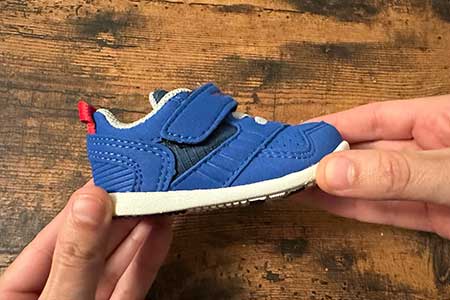
❌ The shoe below has an excessively flexible outsole:
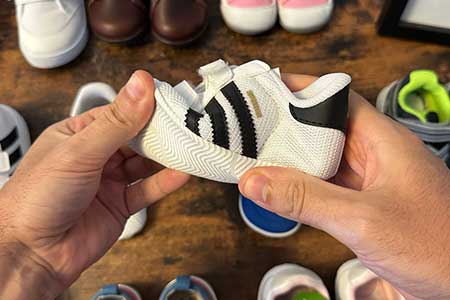
2️⃣ Your second step should be to check if the shoe has a sturdy and well-cushioned footbed. The outsole should absorb impact and conform to the foot’s shape, cushioning each step your child takes.
✅ The shoe below provides a cushioned footbed. Press on the middle part of your child’s outsole and make sure it feels firm as the shoe in the image below:
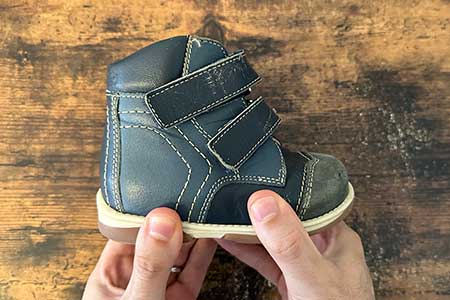
❌ If you press on the middle part of the outsole and the shoe bends, that makes the shoes doesn’t provide the correct amount of support.

3️⃣ Your third step should be to check if the shoe provides good ankle and heel support. We can check this by pressing on the heel counter of the shoe.
✅ The shoe below provides a firm heel counter:

❌ The shoe below provides a heel counter that is too soft:

In summary, supportive footwear for kids should offer a stable base of support, a well-cushioned outsole, and firm heel counters, to help improve your child’s foot posture and promote balance.
Children’s feet are constantly developing. This means the bones, muscles, and tendons in their feet are more malleable and subject to influence from the external environment, like their shoes.
Where Can You Find Supportive Shoes for Your Child?
There is a different resource I created that has specific supportive shoe recommendations for children with foot problems.
Professional Insights: My Experience as a Shoe Fitter
As a former shoe fitter, I’ve helped hundreds of children with foot problems find the perfect pair of shoes for their feet. Through this journey, I’ve learned that no two feet are the same, and the same pair of shoes won’t work for every child.
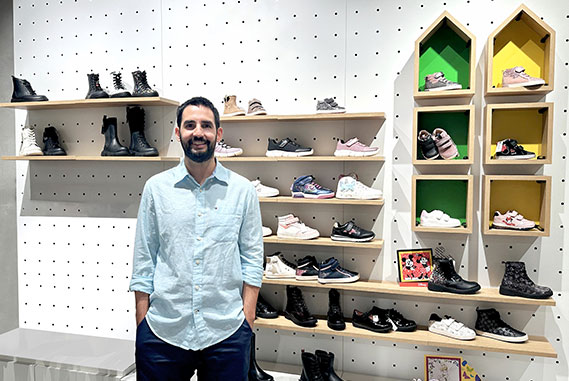
The Importance of Getting the Shoes in the Correct Size
When shoes are too large or too small, they fail to offer the necessary support, regardless of how well-made they might be. The right fit keeps the foot firmly in place, giving the structural support a shoe is designed to provide.
Supportive shoes aren’t just about the thickness of the sole or the brand name; it’s also about how the shoe fits the child’s foot shape (narrow, medium, wide, extra wide), enabling it to move naturally while providing protection and alignment. I can help you figure out exactly what shoe size you should order with a free virtual shoe fitting service I created.
The best piece of advice I can offer? Have your child’s feet measured professionally at least three times a year. If you want to visit your child’s shoe store more frequently, do so. Feet grow unpredictably, and wearing shoes that are too small can lead to a host of foot problems and aggravate your child’s foot condition.
What Are the Most Common Foot Problems in Children?
I have noticed that flat feet and in-toeing are the most common ones. Flat feet refer to a lack of arch in the foot, which can be normal in toddlers but concerning if persistent. In-toeing, often known as “pigeon-toed”, describes a condition where the feet turn inward when walking. I also have seen many children who walk on their toes, but again, this can be part of exploring movement and balance. However, you must watch closely how this behavior progresses over time.
How Can You Tell If Your Child Needs Supportive Shoes?
The signs that your child may need better shoe support include complaints of foot pain, visible wear on shoes that’s uneven or accelerated, or if they seem clumsy or have an unusual gait. If you notice any of these signs, or if your child has flat feet or overpronation, investing in good supportive shoes is key.
If you’re uncertain about the severity of your child’s foot condition, seeking professional advice is recommended.
Recommended Practices for Maintaining Supportive Shoes
Maintaining the integrity of your kids’ shoes is crucial so your child’s feet can stay supported until your child is ready to outgrow his or her shoes. Ongoing care plays a HUGE role. It’s essential to remove the laces or open the Velcro straps FULLY when putting on or taking off the shoes. This practice prevents the shoes from stretching out of shape, ensuring that they continue to give the best possible support.
Don’t forget that the heel counter (back part of the shoe), is an essential feature to keep your child’s feet supported. Every time your child removes the shoes without undoing the laces or velcro straps, the heel counter gets softer.
By the way, shoes with insufficient support can lead to plantar fasciitis or Sever’s disease, which is a heel pain that occurs during growth spurts. The correct type of supportive shoe can make all the difference in helping treat and prevent your child’s foot condition from getting worse.
Finally, if you have questions or if you’re unsure about how to choose the right shoes for your kids, don’t hesitate to reach out. You can contact me via email or drop your queries in the comments section below. I’m here to help guide you toward footwear selections that bolster your child’s foot health and development.

